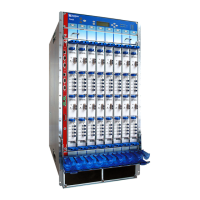[edit]
root@# set system login user user-name class super-user
Configuring System Attributes
For more information on configuring the backup routing and static routes, see the Junos
OS Administration Library.
1. Configure the name of the router. If the name includes spaces, enclose the name in
quotation marks (“ ”).
[edit]
root@host# set system host-name host-name
NOTE: The DNS server does not use the hostname to resolveto the correct
IP address.This hostname is used todisplaythe name of the routing engine
in the CLI. For example, this hostname showson the command-line prompt
when the user is logged on to the CLI:
user-name@host-name>
2. Configure the IP address of the DNS server.
[edit]
root# set system name-server address
3. Configure the router’s domain name.
[edit]
root@# set system domain-name domain-name
4. Configure the IP address and prefix length for the router’s management Ethernet
interface.
NOTE: The RE-C1800 Routing Engine (RE-DUO-1800) does not support
the fxp0 interface or the fxp1 and fxp2 internal Ethernet interfaces. Use
the em0 interface for the RE-C1800 Routing Engine, and fxp0 interface
for all other Routing Engines supported for the router.
[edit]
root@# set interfaces fxp0 unit 0 family inet address address/prefix-length
[edit]
root@# set interfaces em0 unit 0 family inet address address/prefix-length
5. Configure the IP address of a backup routing engine. The backup routing engine is
used while the local router is booting and if the routing process fails to start. After the
routing process starts, the backup routing engine address is removed from the local
routing and forwarding tables.
253Copyright © 2017, Juniper Networks, Inc.
Chapter 23: Configuring the Junos OS Software

